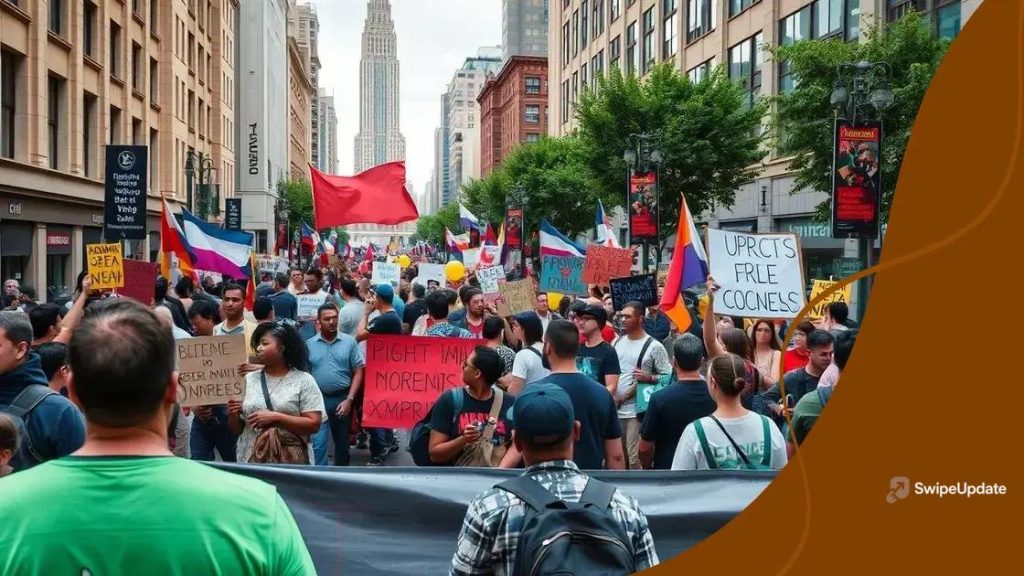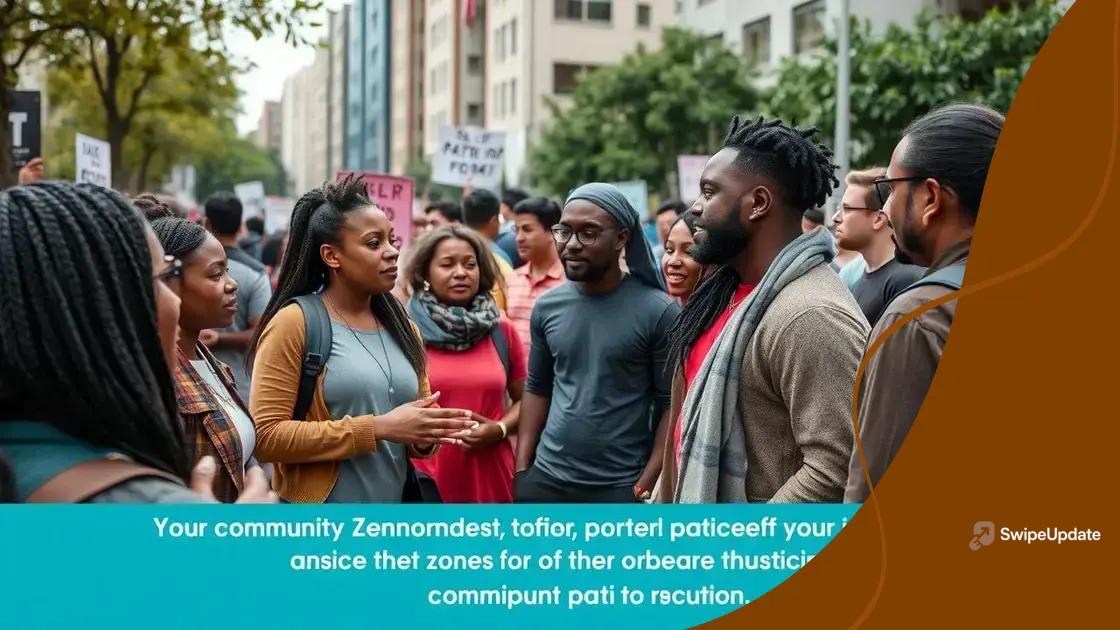Urban protest zones: understanding their evolution and impact

Urban protest zones are designated public spaces where activists gather to advocate for social change, employing technology and diverse strategies to amplify their messages and foster community engagement.
Urban protest zones have become focal points for social movements, representing the heart of activism in cities worldwide. Have you ever wondered how these areas shape public discourse and community spirit? Let’s dive into their significance.
The rise of urban protest zones
The phenomenon of urban protest zones has seen a notable rise in recent years. These areas have become essential spaces for activism, allowing communities to voice their concerns and advocate for change.
This growth reflects a shift in how people engage with social issues. Many individuals are drawn to these zones as places to meet like-minded activists, creating a sense of belonging. Now, let’s explore a few key characteristics that define these protest zones.
Characteristics of Urban Protest Zones
Urban protest zones often share common features that enhance their effectiveness. Here are some important aspects:
- Accessibility: These zones are typically located in areas with high foot traffic, making it easy for participants to gather.
- Symbolic locations: Many protests take place in front of government buildings or other significant sites, emphasizing the message.
- Diverse participation: In these zones, individuals from various backgrounds come together, showcasing community solidarity.
- Legal protection: Some areas are designated as free speech zones, providing legal backing for protest activities.
Moreover, the dynamics of these protests are fascinating. They often inspire spontaneous gatherings, where participants respond to current events and crises. The energy of a protest zone can change depending on numerous factors, including the political climate and social media influence. Activists use these platforms to organize and amplify their messages, attracting more people to join in.
This transformation in public spaces is significant. It signals a growing willingness to address pressing social issues and demands from the populace. As cities evolve, the role of urban protest zones continues to shape the landscape of community engagement.
Key characteristics of these zones
Understanding the key characteristics of urban protest zones is essential to grasp their role in modern activism. These zones provide spaces where individuals come together to express their views, making them crucial for community engagement.
One of the defining features is their accessibility. Urban protest zones are often located in places where people naturally gather, such as parks or city squares. This makes it easier for individuals to join in and become part of the movement. Along with accessibility, these zones often hold symbolic importance. For example, many protests occur near government buildings to emphasize the need for change.
Diverse Participation
Another remarkable aspect of urban protest zones is the diversity of participants. People from all walks of life come together, sharing their stories and concerns. This diversity strengthens the message of the protests, showcasing a united front. In these spaces, you can see:
- A mix of ages and backgrounds.
- People uniting under common causes.
- Opportunities for dialogue between activists and the community.
Furthermore, many urban protest zones have legal protections that recognize them as areas for free speech. This allows individuals to express their views without fear of repercussion. As communities embrace this notion, new dimensions of activism emerge.
These characteristics make urban protest zones dynamic environments filled with energy and passion. They foster a sense of community and provide a platform for voices that might otherwise remain unheard. Through these zones, many people find the strength to advocate for social change, bringing attention to issues that matter most.
Impact on community engagement

The impact of urban protest zones on community engagement is profound and far-reaching. These spaces not only facilitate protests but also foster connections among residents. When people gather in these zones, they share their experiences and develop a sense of community.
One crucial aspect of this engagement is the opportunity for dialogue. Urban protest zones serve as platforms for discussions on pressing social issues. Participants often exchange ideas and solutions, empowering each other to take action. This continuous conversation helps to build trust and solidarity among diverse groups.
Building Awareness and Civic Participation
Moreover, these zones play a vital role in raising awareness about societal problems. As communities gather, they highlight issues that often go unnoticed. This increased awareness can lead to higher levels of civic participation, encouraging individuals to become more involved in local governance and advocacy.
- Residents learn about important social issues.
- Community members discuss potential solutions.
- People are motivated to register to vote or participate in local meetings.
Additionally, the sense of belonging that urban protest zones cultivate cannot be underestimated. When people feel connected to their community, they are more likely to engage in activities that promote positive change. This sense of togetherness transcends individual concerns and focuses on collective goals.
In essence, the impact on community engagement can be seen in the increased participation in local initiatives and a deeper understanding of shared challenges. As more individuals gather in protest zones, the ripple effect can transform neighborhoods, leading to sustained action and advocacy.
How governments respond to protests
Understanding how governments respond to protests is crucial in today’s society. Responses can vary significantly based on the political climate and the nature of the protest. Some governments choose to engage positively with protesters, while others may respond with force or repression.
Engagement often involves dialogue and negotiation. In places where governments see protests as a chance for reform, they might initiate conversations with community leaders. This approach shows an understanding of the issues raised and can potentially lead to productive outcomes.
Different Strategies
On the other hand, some governments may employ various strategies to manage protests, including:
- Increased police presence to maintain order.
- Temporary curfews to control gatherings.
- Legal actions against organizers to deter further protests.
- Public statements aimed at delegitimizing the protest messages.
In many cases, the response depends on public sentiment. If the majority of citizens support the protest, the government may tread lightly. However, if the sentiment is mixed or negative, harsher tactics could be deployed. This creates a complex dynamic, as leaders navigate public opinion while attempting to maintain control.
Additionally, the rise of social media has changed how governments monitor and respond. They can quickly assess the scale of protests and adapt their responses accordingly. This real-time feedback can lead to swift actions that may either exacerbate or diffuse tensions.
Overall, the manner in which a government reacts to protests reflects its values and priorities. The balance between maintaining order and respecting citizens’ rights is often delicate and can significantly impact community trust.
Future trends in urban activism
The future of urban activism is evolving rapidly as society adapts to changing technologies and social dynamics. New trends are emerging that shape how activists organize, communicate, and achieve their goals. As we look ahead, understanding these trends is essential for grasping the future landscape of protests and community engagement.
One significant trend is the increasing reliance on technology. Activists are using social media not just to spread news but also to organize events and mobilize supporters quickly. Platforms like Twitter, Instagram, and Facebook allow for swift communication, making it easier to share vital information. This tech-savvy approach enhances outreach and effectiveness.
Rise of Digital Activism
Additionally, the rise of digital activism cannot be overlooked. Many campaigns now take place primarily online, featuring petitions, crowdfunding, and virtual rallies. These new methods allow people to participate in movements from anywhere in the world. As a result, traditional boundaries of activism are shifting.
- Online petitions can gather thousands of signatures in just hours.
- Virtual meetings foster global discussions about local issues.
- Creative videos and artwork spread messages widely.
In addition to digital activism, there is a growing focus on intersectionality. Activists are recognizing the importance of addressing various social issues, such as race, gender, and economic inequality. This holistic approach encourages collaboration across different groups and movements, uniting voices for a stronger impact.
An important aspect of future urban activism is the emphasis on sustainability. Many activists are pushing for environmentally friendly practices within movements. This includes using sustainable materials for signs or advocating for policies that protect the environment. As more individuals become aware of climate issues, such activism is gaining traction.
Overall, the transformation of urban activism reflects a broader societal shift toward inclusivity and technological integration. By embracing these changes, future movements can harness new tools and strategies to advocate for change effectively.
FAQ – Frequently Asked Questions about Urban Protest Zones and Activism
What are urban protest zones?
Urban protest zones are public spaces where individuals gather to advocate for social change, raising awareness about community issues.
How has technology impacted urban activism?
Technology, especially social media, allows activists to organize quickly, spread information widely, and engage a larger audience in their movements.
What role does sustainability play in activism?
Sustainability is increasingly important in urban activism, as many groups are adopting eco-friendly practices and advocating for environmental policies.
Why is intersectionality important in social movements?
Intersectionality allows activists to address multiple social issues together, fostering collaboration among diverse groups to create a more significant impact.
